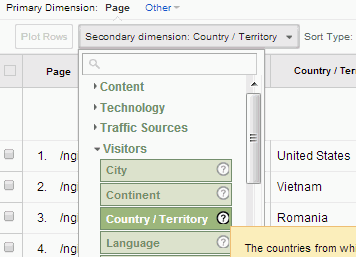How to Make Use Of Secondary Dimension in Google Analytics for Deeper Insights
How to Make Use Of Secondary Dimension in Google Analytics for Deeper Insights
Blog Article
Unlock Deeper Insights With Secondary Dimension in Google Analytics
With the vast stretch of data readily available in Google Analytics, the usage of second measurements can substantially enhance your analytical abilities. By strategically including secondary measurements into your analysis, you can discover beneficial insights that might or else remain undiscovered - Secondary Dimension in Google Analytics.
Recognizing Main Vs. Additional Dimensions
When assessing data in Google Analytics, it is necessary to compare additional and main measurements to get much deeper understandings into individual actions. Primary dimensions are the primary groups whereby you can watch your information, such as touchdown, source/medium, or gadget page. These measurements give the fundamental structure for organizing and comprehending your information. On the other hand, additional measurements permit you to more study your key dimension information. By including a secondary dimension, you can layer on additional information to your main dimension, making it possible for an extra granular evaluation. For instance, if your primary dimension is the source/medium with which individuals arrived on your site, adding a second measurement like geographical place can reveal where those users are located geographically. This added layer of information can aid you recognize fads, patterns, or abnormalities that may not have been evident when considering the main dimension alone. Therefore, leveraging both secondary and main measurements in Google Analytics is critical for detailed data analysis and educated decision-making.
Utilizing Secondary Measurements Properly
Successfully making use of additional measurements in Google Analytics enhances the depth and granularity of data analysis, supplying important insights into individual behavior and patterns. By including second dimensions alongside main dimensions, marketing professionals and experts can dive deeper into the specifics of individual interactions on their sites. Additional measurements permit users to section and filter main measurement information even more, supplying an extra comprehensive view of individual communications, actions, and demographics. This can be especially valuable when attempting to recognize the influence of particular variables on customer interaction, such as the internet browsers or devices they are using, the resources of their traffic, or their geographical places.
Additionally, secondary measurements allow individuals to compare and contrast various information points within a solitary report, facilitating a more extensive evaluation of individual actions patterns. By leveraging additional dimensions efficiently, organizations can discover surprise insights, enhance their marketing techniques, and improve the total individual experience on their internet sites.
Checking Out Usual Secondary Measurement Combinations
To even more assess individual actions and patterns in Google Analytics, it is valuable to check out common mixes of secondary measurements. Some common secondary dimension combinations that offer useful insights include evaluating website traffic sources with customer areas to comprehend where website visitors are coming from geographically and how they located the site. Checking out individual behavior metrics with additional measurements such as demographics or interests can help in targeting particular target market sectors much more efficiently.
Using Additional Measurement in Custom Reports
Using second dimensions in custom-made records allows for a more extensive analysis of data in Google Analytics, boosting the depth of understandings acquired. When creating custom-made records in Google Analytics, incorporating second dimensions can offer a much more comprehensive sight of exactly how various measurements communicate with each other. This function allows customers to delve deeper into their information and reveal valuable connections that may not be immediately apparent.
By applying second dimensions in custom reports, customers can get a much better understanding of navigate here their internet site or application web traffic. Incorporating the key dimension of "source/medium" with the secondary dimension of "touchdown page" can reveal which touchdown web pages are performing best for traffic coming from details resources. This understanding can help marketing experts optimize their campaigns and boost general conversion rates.

Enhancing Data Visualization With Additional Dimension
When checking out data in Google Analytics customized records, incorporating second dimensions not just supplies an extra comprehensive analysis however additionally enhances the graph of insights with information visualization. By adding a second dimension to your reports, you can enrich the method information is provided, making it less complicated to determine patterns, fads, and relationships within your site's efficiency metrics.
Second dimensions can assist you sector your information better, enabling for a much deeper understanding of individual actions and communications pop over to this site on your site. When trying to isolate certain variables that might influence your website's performance., this improved level of granularity can be particularly helpful.

Conclusion
In conclusion, leveraging second measurements in Google Analytics permits an extra detailed analysis of information, leading to much deeper insights and even more enlightened decision-making. Secondary Dimension in Google Analytics. By including extra layers of details to key information collections, marketing experts and analysts can uncover covert trends, patterns, and relationships that provide a granular sight of individual behavior and interactions. This enhanced degree of insight enables optimization of projects and tailored approaches for particular target market segments, inevitably improving performance and conversion prices
On the various other hand, secondary dimensions enable you to more study your key a knockout post dimension information. By adding an additional dimension, you can layer on additional info to your key dimension, allowing an extra granular analysis. If your main measurement is the source/medium via which users showed up on your website, adding a secondary dimension like geographical area can reveal where those individuals are situated geographically. By including secondary dimensions together with primary dimensions, marketing experts and experts can dive much deeper right into the specifics of customer communications on their sites. Additional measurements enable customers to segment and filter primary dimension data additionally, offering an extra in-depth sight of user habits, demographics, and interactions.
Report this page